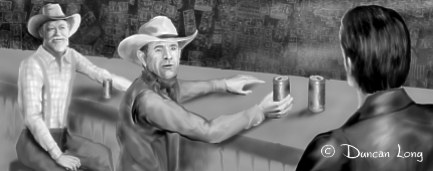Rough Sketchs and Final Illustrations
filed in Book Artwork and Illustrations on Aug.27, 2010
Rough sketches can be useful for discovering what works best for the layout of a book or magazine illustration. They can be whipped off in minutes, and quickly show whether or not a layout is likely to look good.
Generally artists try to avoid showing uninitiated clients these drawings as they can easily be mistaken for a childhood scrawl or something found deep in a cavern occupied by semi-skilled cave people.
So here’s the warning: All sketches and rough drawings may be, well, rough.
(Above is the rough sketch I created for the finished picture below, part of my on-going set of illustrations for John Chadwell’s graphic novel Werewolves of New Idria, to be published by Moonstone Books.)
When picking an artist to create a book illustration, the key thing is to check his finished work to see if his style and level of polish are what you want to eventually see. If his style is not what you have in mind, continue your search. If it looks like what you want, then don’t worry about what the rough sketches look like; remember they are only quick doodles to get the project headed in the right direction.
Remember: Rough sketches save time and effort. An illustrator can create a sketch in minutes; it may take days to do the finished illustration (especially for realistic styles like I regularly create). That translates into saved time for the artist, and a lower price tag for his work. It is a win-win situation.
So when you see a rough sketch, don’t panic. Just study the layout and try to imagine the finished picture to be sure the artist is headed in the right direction. Once you and he agree on that basic layout, eventually there will be a polished final illustration that looks the way you want.
And you and your artist won’t have wasted a lot of time and effort on layouts and designs that will never work.
=====================
Duncan Long is a freelance book cover illustrator for HarperCollins, PS Publishing, Pocket Books, Solomon Press, Fort Ross, and many other publishers and self-publishing authors. See his cover illustrations at: http://DuncanLong.com/art.html

